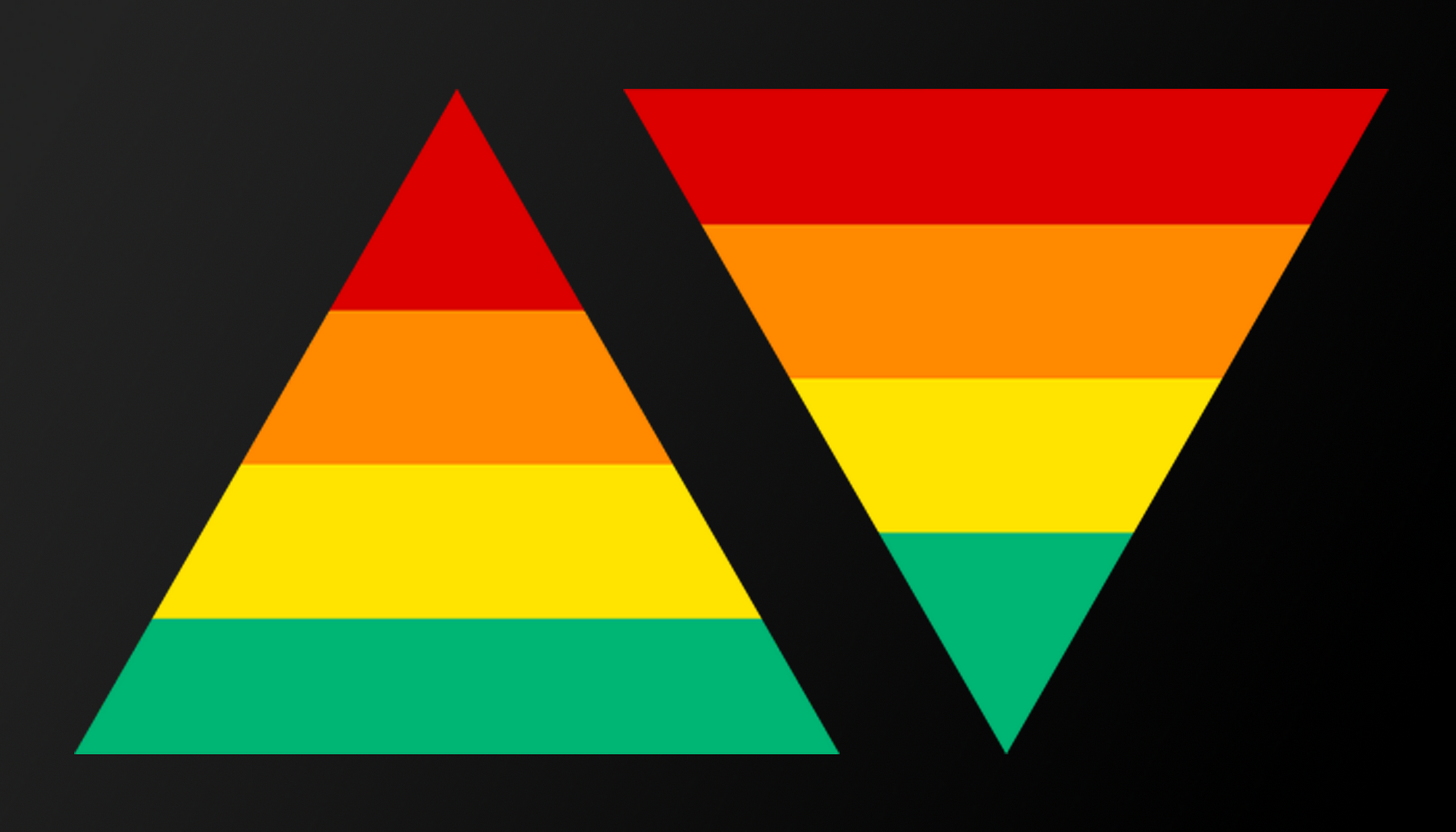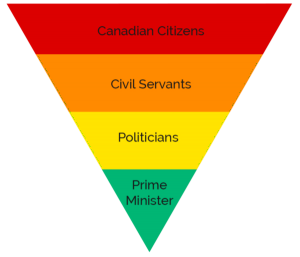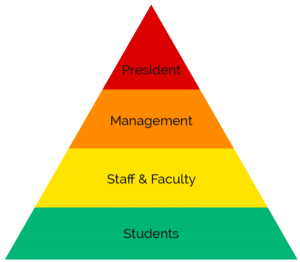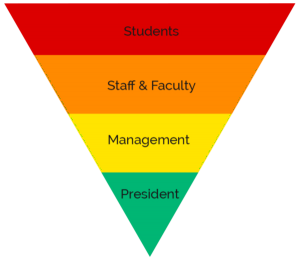Flipping Organizational Hierarchy on Its Head

WHO WE SHOULD ACTUALLY WORK FOR
The concept of organizational hierarchy is one that exists in many of our everyday professional lives, but it’s not what we typically call it. Perhaps you’ve heard it called “power structure”, “reporting structure” or “my boss’ boss’ boss”. It happens when one person or group of people are in power, meaning they have the most influence on the goals and objectives of the organization. Below them, there are varying levels of power and influence written into job titles.
These hierarchies are based on boss-employee relationships all throughout the institution. In fact, the vast majority of people in the workforce are subordinate to someone. What typically happens in these worlds is subordinates work for — and try only to impress — the power level above them on the hierarchical pyramid. Maybe it’s because they hired you or pay you, but we are trained to impress our bosses at work.
This is an idea so written into our societal values, it is hard for generations to reframe the thinking: you work for your boss and that’s the way it has always been done. But as my talented business partner believes: “Doing things because ‘that’s the way it has always been done’ is a horrible reason to continue doing anything.”
. . .
I have worked in the education space for almost 4 years, so a lot of this piece pulls from my experience working in a hierarchical university setting as my reference. However, I have also worked in the largest news and media organizations in the country and the concepts hold true everywhere.
If you’re not in education; if you offer any product or service to people, I challenge you to replace “student” in the following example with “customer” or “end user”. Replace the goal of our institution with the goal of yours, whatever that may be. The model still holds true.
I remain consistent in my belief that we need to flip this organizational hierarchy on it’s head.
. . .
TRADITIONAL ORGANIZATIONAL HIERARCHY
In this traditional educational hierarchy, the President of the university is alone at the top. They are at the top, and red, because they are the most important. They hold the most power.
There is significantly more management, staff, and faculty, but they are under the president. They hold less power, but they support the top dog’s existence and place on the pyramid.
Remembering we’re in an academic institution, students – the reason why we exist – seem to find themselves at the bottom of this pyramid. By being at the bottom and the largest group, they support the rest of the institution, but they are somehow the ‘least important’. In this model the students are trying to impress their professors or supervisors. The staff and faculty are trying to impress their bosses and ultimately everyone is trying to hold up and impress the president.
This makes no sense to me.
Especially in an educational institution where we exist to help students learn and succeed, why are our main stakeholders, the ones we do everything for, the ones that pay our salaries; why are they on the bottom of this hierarchy? Because we have we found ourselves constantly trying to impress thoseabove us on this pyramid. We work for them. However, if this the way we are, then sure, let’s continue working for those above us, but let’s change who is above us.
Here’s the way I think about what I do when working for students…
A NEW ORGANIZATIONAL HIERARCHY
In this model, students are the most important. They are at the top of the pyramid and should have the most power and say in their success.
The staff and faculty are just below students supporting that success no matter how that student defines it. Their bosses are below them, enabling and empowering their staff to do just that: support students in whatever way their role entails.
In this model, the president is at the bottom. They are still very important because they hold up everyone else and guide the base of the institution, but ultimately they work to support the personal, professional and academic success of their students and staff.
 Thinking about who we work for in this new way changes our language as well. Instead of saying “I work for Ryerson University”, perhaps we say “I work for students at Ryerson University. We can’t work for the institution. The institution works for its students. Perhaps politicians don’t work for the Government of Canada, but rather work for Canadian citizens with the Government of Canada.
Thinking about who we work for in this new way changes our language as well. Instead of saying “I work for Ryerson University”, perhaps we say “I work for students at Ryerson University. We can’t work for the institution. The institution works for its students. Perhaps politicians don’t work for the Government of Canada, but rather work for Canadian citizens with the Government of Canada.
In my experience, the barrier to adopting this way of being comes from a fear that sounds like, “If I’m not impressing my superior, how will they notice me? Will I get a raise or promoted? Will they be mad that they are not my first priority?” Here’s what I say:
- If your supervisor is mad that your first priority is your student or customer, the supervisor needs to do some self analysis and reevaluate the “why” of their institution. I doubt the goal of any institution is “We as employees aim to make 0ur supervisors happy.”
- Trust that if you deliver enough value to students; if so many of your customers are paying attention; if your engagement rates rise; if sales improve, your bosses can’t overlook that. As Steve Martin once said, “be so good they can’t ignore you.”
“Increasing shareholder value” cannot be the goal of your organization. The goal needs to be focused on value for the end user. The quintessential brands — Nike, Apple, Facebook — if they made decisions based explicitly on shareholder value, their products and experiences would suffer. Rather, these brands focus on the end users’ experience and in doing so, increase shareholder value as a natural byproduct of increased user value. This is the model we must take everywhere. It provides stronger organizational focus, ensures you’re meeting the true mission behind your company, and most importantly, provides value for everyone involved, from the top of the pyramid to the bottom.
. . .
For more blogs by me, check out my full Medium page.
Follow me on Twitter @BaileyParnell for all updates, stories & more!






